
A Cultural History of Shopping in the Age of Revolution and Empire
(Hardback)
Publishing Details
A Cultural History of Shopping in the Age of Revolution and Empire
By (Author) Erika Rappaport
Series edited by Jon Stobart
Bloomsbury Publishing PLC
Bloomsbury Academic
25th July 2024
United Kingdom
Classifications
Tertiary Education
Non Fiction
381.09
Physical Properties
Hardback
272
Width 170mm, Height 246mm, Spine 20mm
667g
Description
Shopping emerged as a special pleasure and problem during the period between the revolutionary upheavals of the late 18th century and the opening salvoes of the Great War. New shops, new products, new class and gender ideologies, new standards of comfort and hygiene, and rising living standards for some meant that people, especially women, spent more time shopping and engaging in consumer-oriented activities beyond the walls of the shop. At the same time, social commentators, local and national authorities, economists, and many husbands became concerned about the dangers of shopping, believing that the department store was emancipating women and destroying society in the process. This volume explores shopping in the 19th century as a varied and embedded social, political, economic, and cultural activity. It draws out the continuities with earlier periods as well as examining how the department store came to be seen as both symbol and generator of profound economic, social, and cultural change. A Cultural History of Shopping in the Age of Revolution and Empire presents an overview of the period with themes addressing practices and processes; spaces and places; shoppers and identities; luxury and everyday; home and family; visual and literary representations; reputation, trust and credit; and governance, regulation and the state.
Author Bio
Erika Rappaport is Professor in the Department of History, University of California, Santa Barbara, USA.
